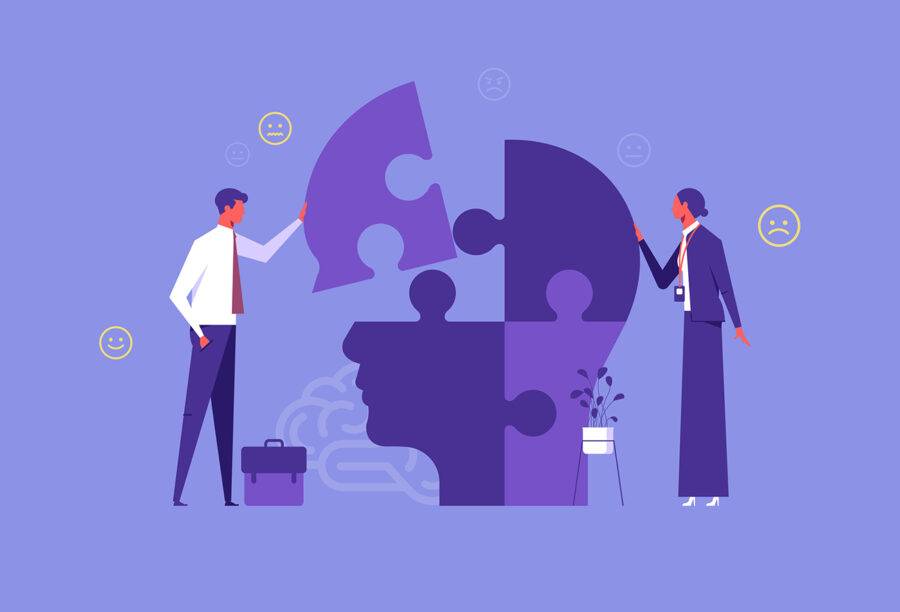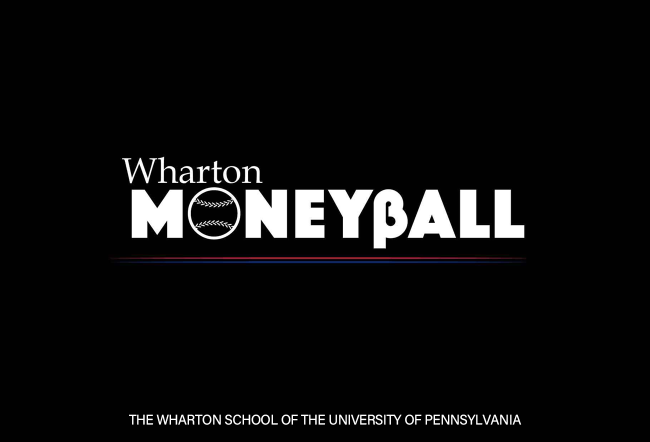The following article is written by experts at the Wharton Neuroscience Initiative and global consulting company Slalom*, who conducted a series of neuroscience experiments with employee volunteers to learn more about improving workplace culture, teamwork, productivity, and more.
Countless management and HR blogs, articles, and books are packed with advice about best practices for improving workplace culture, making teamwork more effective, and ways to stay on task and get the most out of meetings. In parallel, organizations often query employees with self and peer assessments to better understand employee engagement. So why don’t those approaches always work? Most organizations don’t take a neuroscience perspective into account. What people can and are willing to self-report does not always predict their behaviors, decisions, and outcomes. Moving the needle requires getting neuroscience out of the lab and measuring neural activity in the real world and in real contexts. That is, we need to measure our brains while we do work at work, quite literally.
To do just that, Slalom, a global consulting company, and the Wharton Neuroscience Initiative (WiN) set out to do something together in 2022–2023 that had never been done before. With guidance and expert oversight, Slalom employee volunteers agreed to measure their own brain activity while engaged in their real work. This data was then analyzed jointly by WiN and Slalom. This unique collaboration to get neuroscience out of the lab and “into the wild” has some provocative implications for driving creative thinking, boosting employee engagement, and fostering enhanced team chemistry.
Studying Brain Activity at Work
In 2021, Slalom’s HabLab, a corporate laboratory focused on improving people and employee experience through research, partnered with WiN to create new thought leadership and explore best practices that all organizations can leverage. This partnership offers a new model of “citizen science,” in which employees help design research questions and learn to collect data on themselves and their teams while on the job — all in the service of making Slalom a better place to work.
In 2022, a group of HabLab employee volunteers called “The Slalom 300” — which included over 650 employees by 2023 — participated in a series of experiments. Following a 1-hour video tutorial, “Slalom 300” volunteers wore an Emotiv brainwave sensing headset at work. If they encountered any difficulties, Slalom and WiN researchers were available to troubleshoot. After data collection, each employee uploaded the data to a secure server and shipped the headset on to the next volunteer. HabLab and WiN data scientists analyzed the data, and then WiN leadership reported the findings and insights back to the “Slalom 300” volunteers and company leaders.
As with all experiments — especially in the “wild” — there were many challenges the “Slalom 300” faced. Employee volunteers had to learn how to use the Emotiv headsets effectively themselves, whereas in a standard laboratory experiment, trained researchers would collect the data. Employee volunteers were also not used to wearing a brain-sensing headset while working, which could be physically uncomfortable after long periods of time. As is the case with anything new, employee volunteers were also unsure of what the headset could really measure and what the implications of their brain data would be for them at work. To allay these concerns and invest the “Slalom 300” with agency as citizen scientists, WiN scientists led several webinars and even a book club discussion of WiN Director Michael Platt’s The Leader’s Brain.
Key Findings for Improving Workplace Culture, Teamwork, and Productivity
Zoom Fatigue Is Real: Taking Breaks Can Make Your Brain Work Better at Work
With virtual meetings becoming the new normal after the pandemic, it has become routine for people to schedule back-to-back meetings, since no one needs to physically travel for meetings anymore. As a result, Microsoft reports “the average Microsoft Teams user spends 252 percent more time in weekly meetings compared to February 2020”. But is this really the best way to meet and work?
In a small pilot study published in 2021, Microsoft WorkLab reported that back-to-back meetings depress brain signals associated with joy and the motivation to work. HabLab and WiN built upon and extended this finding by studying a larger group of Slalom employees taking real meetings online and focusing on brain signals linked to deep, creative thinking. By instruction, each of the 25 “Slalom 300” volunteers wore the Emotiv headset on a day where they had at least three back-to-back meetings, each lasting at least 30 minutes. They also wore the headset on another day where they attended at least three meetings, with the option to schedule and take a minimum of a 10-minute break between them. In addition, they were asked to answer a few questions about the dynamics of the meeting on both days.
Breaks had a significant impact on brain activity. Taking 10 minutes between meetings led to increases in brain signals associated with lower stress and deep, creative thinking. Specifically, alpha power relative to beta power was higher after taking a break — indicating greater relaxation and lower stress. Delta power also increased significantly after taking breaks (Figure 1). During these breaks, participants were instructed to fully disconnect from their work and take a 10-minute break, such as going for a walk or taking a bio break. Although increased delta power is typically associated with sleep, when this signal increases during task performance — such as a work meeting — it indicates less distraction and more inwardly directed, creative thinking.
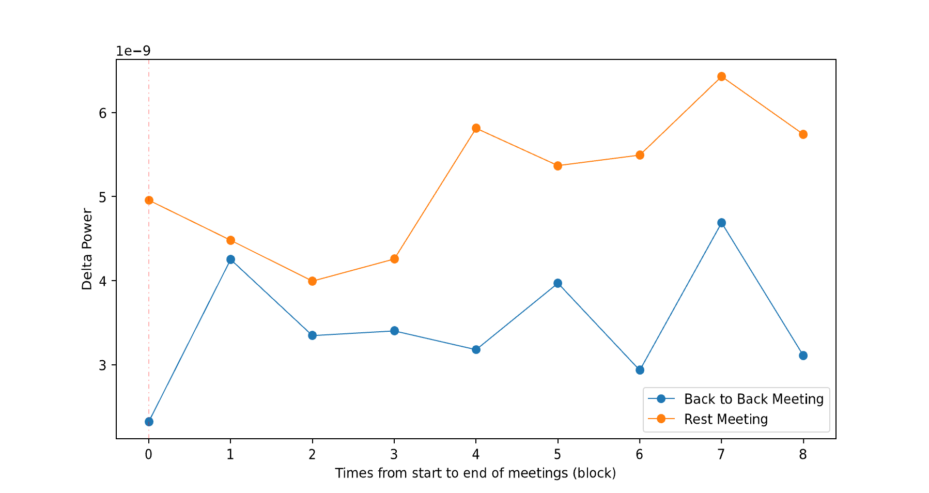
This study makes plain that taking breaks improves physiological indicators of better performance, including reduced stress, less distraction, and deeper, creative thinking. All companies can benefit from implementing 10-minute breaks between meetings as the default option for all scheduling — a feature available in most calendaring apps like Microsoft Outlook and Google Calendar.
Workplace Friendships: Brains That Fire Together Wire Together — Even Online
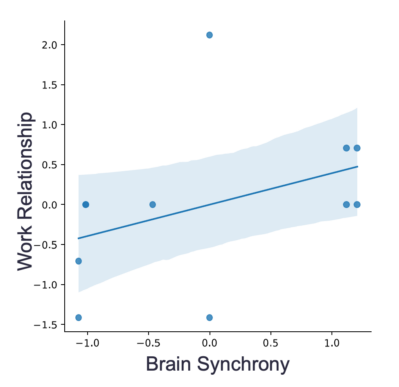
A second part of the experiment required employee volunteers to watch several video clips while wearing the EEG headset at a time when they were not engaged in other tasks. The videos consisted of a talk by Slalom’s CEO; some clips of Slalom’s mission, values, and culture; and other videos ranging in content and style from science documentaries to cute animals to comedy. This is a modification of a study originally designed and conducted by neuroscientists Carolyn Parkinson, Adam Kleinbaum, and Thalia Wheatley at Dartmouth, who explored how the accompanying brain activity can predict friendships. Similar vs. dissimilar patterns of brain activity — so-called “brain synchrony” — may explain why we sometimes seem to ‘click’ easily with one person and not with another.
Together, HabLab and WiN wanted to explore whether work relationships are like friendships, and if so, whether we could predict team chemistry based on brain activity. We specifically hypothesized that employees who reported feeling closer to each other at work would show more similar patterns of brain activity while watching videos. Notably, we found that work relationships are like friendships in that relationship quality was correlated with patterns of brain activity. Employees who rated each other as closer showed more similar brain activity while watching videos than employees who rated each other as less close (Figure 2). What was surprising was that this pattern was most apparent when employees watched a video that promoted Slalom as a great place to work.
These findings suggest employees who work closely together think and feel similarly about their workplace. What remains unknown is cause and effect. That is, whether employees at Slalom develop closer work relationships due to thinking and feeling more similarly at the outset, or if working closely together at Slalom leads employees to develop more similar thoughts and feelings about the workplace. Both factors shape “brain synchrony” in real-world interactions. Perhaps most importantly, our findings indicate that the same brain mechanisms that support friendships in the real world also seem to support chemistry in virtual teams.
Internal Messaging Resonates Less With Employees Who Aren’t Engaged
We examined patterns of brain activity while employees watched a video promoting Slalom as a great place to work. We found that employees who rated Slalom most highly as a company that promotes sharing knowledge and helps them become better leaders showed the highest overall brain activity while watching the video (Figure 3). Our findings suggest Slalom internal messaging resonates most strongly with the most engaged employees.
This observation provoked us to take a deeper dive into the video’s messaging. We focused on brain synchrony because it provides a biometric gauge of collective experience — shared thoughts and feelings — that in prior studies predicted advertising effectiveness in consumers. The brain waves we analyzed provide frame-by-frame insights into how employees respond to the content in the video, without interrupting them to ask questions — a process that itself can alter moment-to-moment experience.

We discovered a large spike in brain synchrony when Slalom’s “love your work and life” tagline appeared on a T-shirt worn by an employee in the video. Digging deeper into this finding, we analyzed brain synchrony in different employee subgroups based on their role in the company and how they rated their employee experience in prior surveys.
Surprisingly, we found a large spike in brain synchrony in response to the “love your work and life” tagline in employees with a local market orientation but not those with a global market orientation. In hindsight, this makes sense because employees who work together in local markets share more experiences both at work and in the local community and are bound together by a shared language and culture. By contrast, employees working in global markets may lack these shared experiences, encounter cultural differences, and face significant time-zone differences with their colleagues around the world. These findings highlight the need to understand the challenges faced by global employees and to take steps to build stronger connections between them and the company.
Action Steps for Improving Workplace Culture Today
HabLab’s “Slalom 300” are actively incorporating elements from the findings into their schedules, such as scheduling 20-minute meetings (that used to be 30 minutes) and 50-minute meetings (that used to be 60 minutes) to allow for breaks between meetings. They are also actively encouraging employees to be mindful about the types of breaks they are taking and advocating for incorporating a healthy mix of break types that include going for a short walk, meditating and breathing exercises, physically stepping away from the computer, etc., mixed with “productive” breaks such as checking emails and chat notifications. Research by Sara Perry and others suggest that the type of break matters, but how cognitively restorative different kinds of breaks might be is a question for further study.
As a result of this partnership, Slalom employees who participated in the experiment reported higher employee experience scores than those who were not part of it (Figure 4).
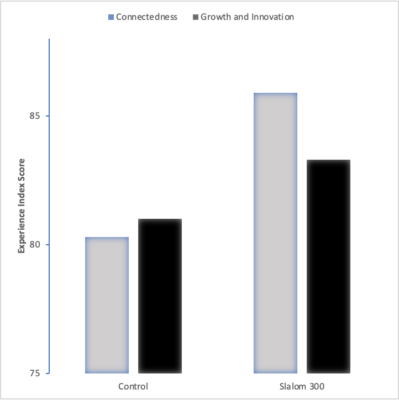
With more opportunities for academic-corporate partnerships in the future, Slalom and WiN encourage other organizations to consider how to use neuroscience to improve employee experience and discover new insights for a more future-oriented workforce. Key takeaways from these research learnings include:
- Learn how to integrate breaks in your workday. You can automatically shorten your meetings with Microsoft’s shortcuts (if your organization is a Microsoft user) and create working norms with your teams about scheduled breaks.
- Multinational companies should discuss ways to help global team members feel more connected, for example through weekly surveys and focus groups.
- Finally, leverage our findings on brand messages to improve clarity and communication around internal and external marketing strategy, specifically focusing on positive emotions like love that broaden our attention and build our internal cognitive and emotional resources.
*Major contributors to this article include Wharton professor Michael Platt, WiN managing director and senior fellow Zab Johnson, and Penn masters student Vartika Parasramka, as well as Slalom’s Natalie Richardson, Emily Foy, and Victoria Villacorta.
